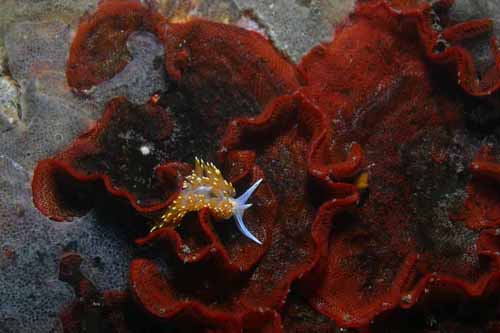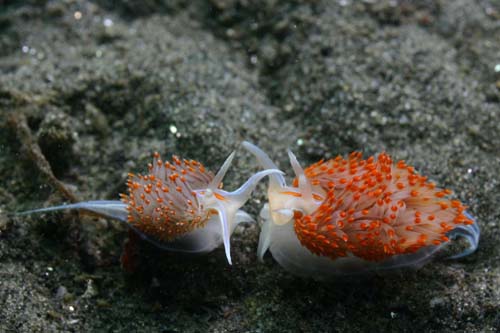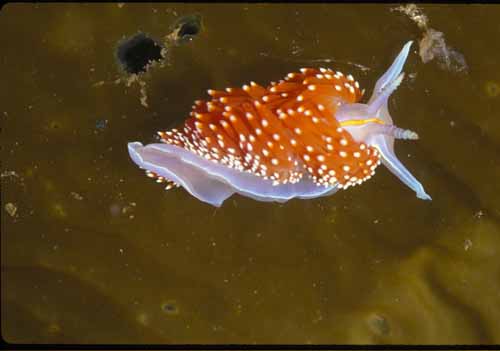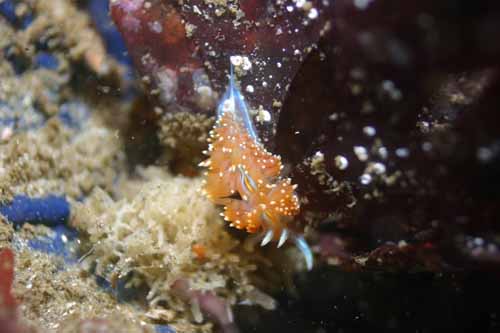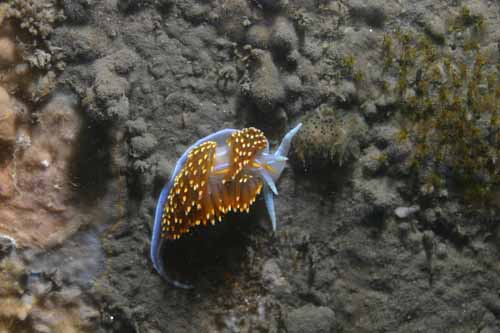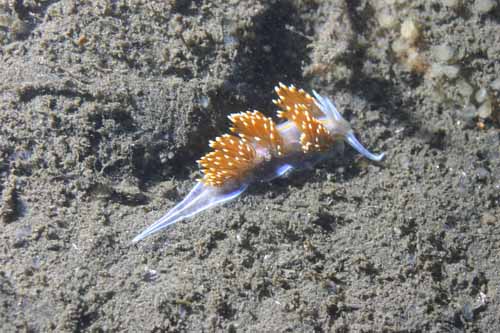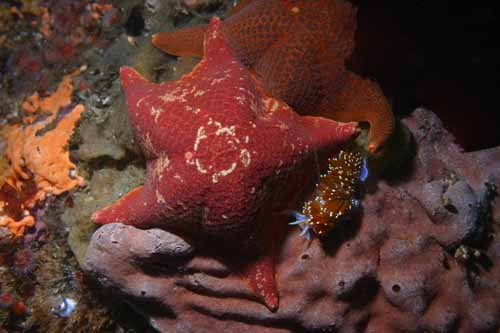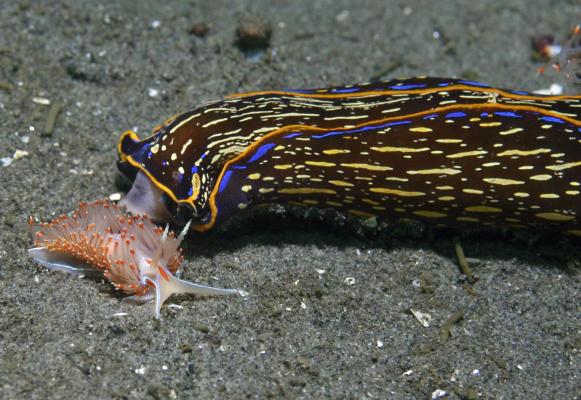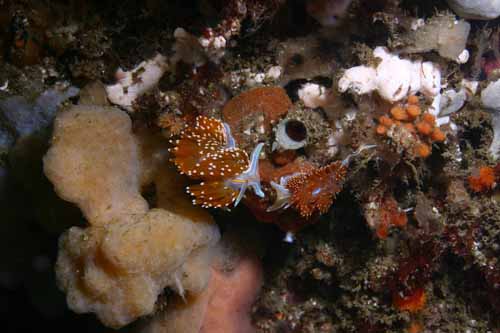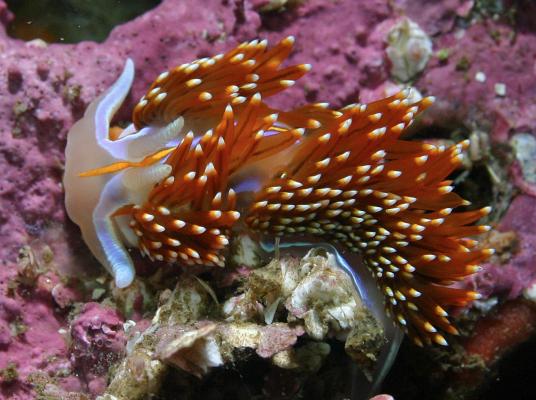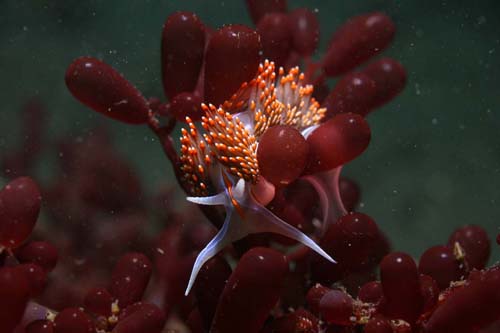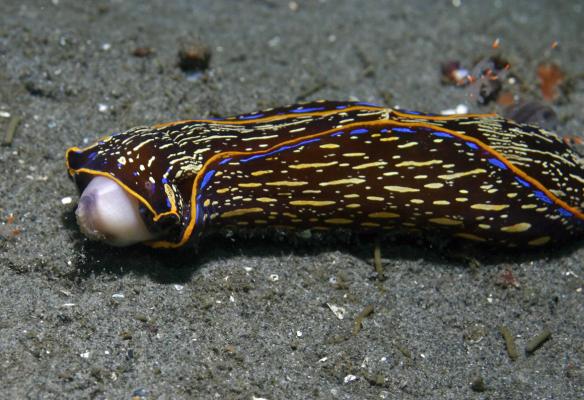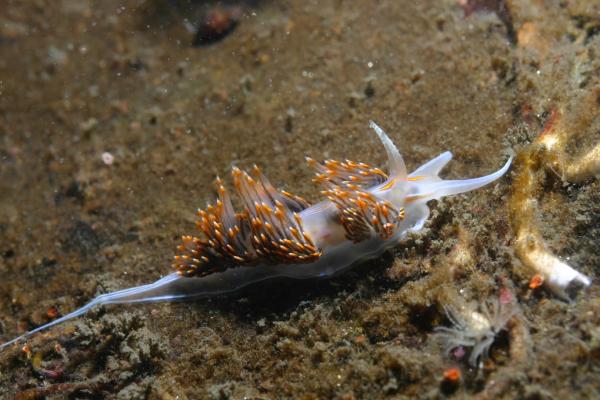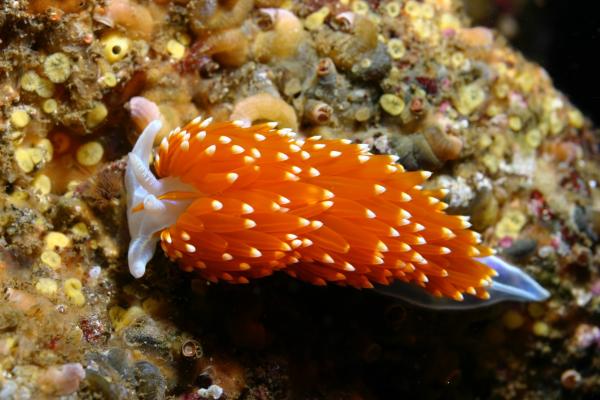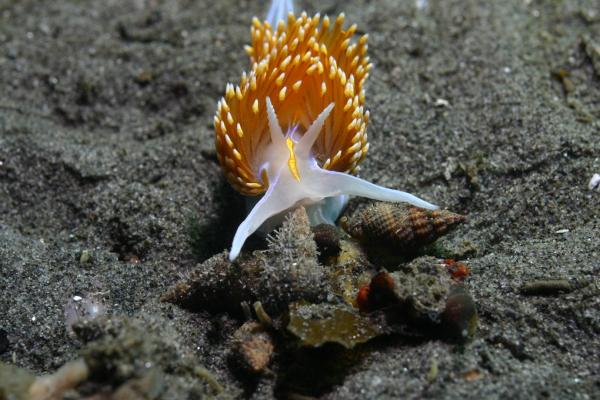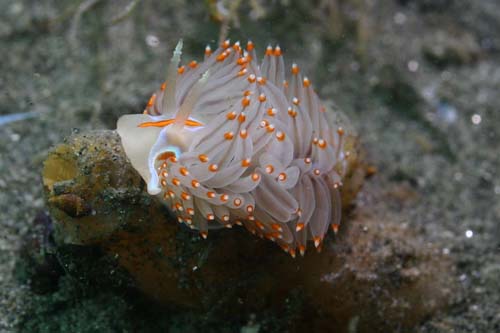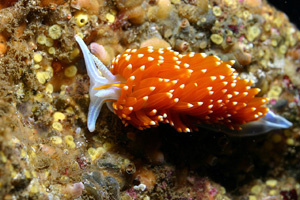
Opalescent Aeolid
Hermissenda opalescens
Overview
Key Features:
The cerata of H. opalescens lack white longitudinal lines, which are instead present on H. crassicornis, a more northern species. Translucent or light blue body with white lines along margin and out onto cephalic tentacles. A bright orange, diamond-shaped line runs between the annulated rhinophores. Cerata are usually orange with light tips.Similar Species:
Horned Aeolid (Hermissenda crassicornis)Primary Common Name:
Opalescent AeolidGeneral Grouping:
Nudibranchs or sea slugsGeographic Range:
Northern California to Sea of Cortez, Mexico.
Northern California to Sea of Cortez, Mexico. The very similar Hermissenda crassicornis ranges from Alaska to central California.Intertidal Height:
-2 to 2 feet (-0.6096 to 0.6096 meters)Notes:
Common in the intertidal.Subtidal Depth Range:
Minimum Depth: 0 meters or 0 feetMaximum Depth: 40 meters or feet
Notes:
Common in the subtidal.Habitats:
bay (rocky shore), estuary, exposed rocky shore, kelp forest, protected rocky shoreNotes:
Often found in areas where hydroids, their prey, are abundant.Abundance:
Relative Abundance:
Common.Species Description:
General:
Hermissenda opalescens is in the class Gastropoda, phylum Mollusca, order Nudibranchia and suborder Aeolidacea. Unlike most mollusks, nudibranchs lack a shell, mantle cavity, and original gill. All members of the suborder Aeolidacea, including Hermissenda opalescens, are characterized by rows of cerata on the back.Distinctive Features:
The body of Hermissenda opalescens is a distinctive bluish white with neon white lines near the base of the foot and a yellow or orange midline stripe. The body is broadest just behind the head, tapering to a fine point at the rear. There are numerous bright orange, white-tipped projections, called cerata, in clusters on each side of the dorm, but a longitudinal white line is absent. Hermissenda opalescens has two annulate rhinophores and two cephalic tentacles that have a blue line.Size:
It can grow to a length of 83 mm and a width of 10 mm.Natural History:
General:
Lindsay and Valdes (2016) published new research that separated Hermissenda crassicornis into three species. Pseudocryptic species are species that could not be differentiated prior to molecular data being analyzed. Instead of a single species ranging from Japan to the Sea of Cortez in Mexico, there are actually three species, one in Japan and Russia, one that occurs in Alaska down to Big Sur, and a third species that occurs from northern California to Mexico. Here in central California, two species overlap: Hermissenda crassicornis to the north and Hermissenda opalescens to the south. The area of overlap is still being investigated by Dr. Valdes and his colleagues.These two species can be easily distinguished by examination of the cerata. The cerata are used in respiration, like branchial plumes in dorid nudibranchs, and they are also used for digestion and to fend off predators. The cerata have extensions of the digestive system, and can have untriggered stinging cells (nematocysts) that are used to ward off predators.
The cerata for the northern species, Hermissenda crassicornis, have white lines that extend upwards. The cerata for the southern species, Hermissenda opalescens, do not have white lines.
Predator(s):
Hermissenda can be eaten by fish, such as the Mosshead Warbonnet, Chirolophis nugatory, or other sea slugs, such as Navanax.Prey:
Hermissenda feeds primarily on hydroids, but may also eat sea anemones, bryzoans, sea pens, sea squirts, corals, sponges, small crustaceans, and even each other.Feeding Behavior:
CarnivoreNotes:
Hermissenda is a generalist carnivore and can detect its prey items through chemical scents in the water. It is also known to be cannibalistic. When two individuals meet, they frequently fight and bite chunks of tissue from each other. Hermissenda is also known to have particularly potent cerata. This may be due to the fact that they prey on organisms with particularly toxic nematocysts, such as solitary corals and strawberry anemones, Urticina lofotensis. Amazingly, these nudibranchs are able to ingest the stinging cells of their prey without discharging the nematocysts, and then use those same stinging cells for their own defense by flailing the cerata and discharging the nematocysts against potential predators.Seasonal Behavior
January - December
Reproduction:
Hermissenda opalescens is a hermaphrodite, meaning it possesses both male and female organs, however, they very rarely self fertilize. Most instead chose to mate and during mating they may spend up to 30 minutes together, touching each other and aligning sexual pores, the actual exchange of sperm lasts only seconds. After sperm exchange, eggs are packaged into narrow coils resembling tiny, pink sausage links and affixed to eelgrass or algae. Quantity of eggs in a ribbon can range from a few to a million. Maturation of the eggs is highly influenced by temperature and can take anywhere from 5 – 50 days. Warm temperatures are most favorable for egg development. The egg matures into a larval stage called a veliger. Veligers will float around on the ocean floor until environmental conditions cause them to settle and develop into adult form. Reproduction can occur year round and the generation time, the time from egg to first reproduction, is about 2.5 months.References
- Lindsay, T. and A. Valdes. 2016. The model organism Hermissenda crassicornis (Gastropoda: Heterobranchia) is a species complex. PLoS ONE 11(4):1-17.
Related Information
Photo Library
Click on an image below to view a larger version in the SIMoN Photo Library. You will also be able to view important information on each photo such as photographer, date, caption and more
